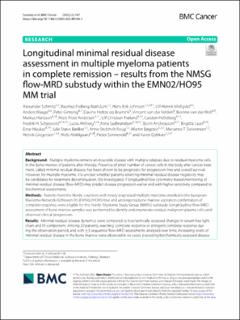| dc.contributor.author | Schmitz, Alexander | |
| dc.contributor.author | Brøndum, Rasmus Froberg | |
| dc.contributor.author | Johnsen, Hans Erik | |
| dc.contributor.author | Mellqvist, Ulf-Henrik | |
| dc.contributor.author | Waage, Anders | |
| dc.contributor.author | Gimsing, Peter | |
| dc.contributor.author | Op Bruinink, Davine Hofste | |
| dc.contributor.author | van der Velden, Vincent | |
| dc.contributor.author | van der Holt, Bronno | |
| dc.contributor.author | Hansson, Markus | |
| dc.contributor.author | Andersen, Niels Frost | |
| dc.contributor.author | Frølund, Ulf Christian | |
| dc.contributor.author | Helleberg, Carsten | |
| dc.contributor.author | Schjesvold, Fredrik Hellem | |
| dc.contributor.author | Ahlberg, Lucia | |
| dc.contributor.author | Gulbrandsen, Nina | |
| dc.contributor.author | Andreasson, Bjorn | |
| dc.contributor.author | Lauri, Birgitta | |
| dc.contributor.author | Haukås, Einar | |
| dc.contributor.author | Bødker, Julie Støve | |
| dc.contributor.author | Roug, Anne Stidsholt | |
| dc.contributor.author | Bøgsted, Martin | |
| dc.contributor.author | Severinsen, Marianne T. | |
| dc.contributor.author | Gregersen, Henrik | |
| dc.contributor.author | Abildgaard, Niels | |
| dc.contributor.author | Sonneveld, Pieter | |
| dc.contributor.author | Dybkær, Karen | |
| dc.date.accessioned | 2022-09-16T09:11:47Z | |
| dc.date.available | 2022-09-16T09:11:47Z | |
| dc.date.created | 2022-04-27T10:56:40Z | |
| dc.date.issued | 2022 | |
| dc.identifier.citation | BMC Cancer. 2022, 22:147 (1), 1-11. | en_US |
| dc.identifier.issn | 1471-2407 | |
| dc.identifier.uri | https://hdl.handle.net/11250/3018368 | |
| dc.description.abstract | Background
Multiple myeloma remains an incurable disease with multiple relapses due to residual myeloma cells in the bone marrow of patients after therapy. Presence of small number of cancer cells in the body after cancer treatment, called minimal residual disease, has been shown to be prognostic for progression-free and overall survival. However, for multiple myeloma, it is unclear whether patients attaining minimal residual disease negativity may be candidates for treatment discontinuation. We investigated, if longitudinal flow cytometry-based monitoring of minimal residual disease (flow-MRD) may predict disease progression earlier and with higher sensitivity compared to biochemical assessments.
Methods
Patients from the Nordic countries with newly diagnosed multiple myeloma enrolled in the European-Myeloma-Network-02/Hovon-95 (EMN02/HO95) trial and undergoing bone marrow aspiration confirmation of complete response, were eligible for this Nordic Myeloma Study Group (NMSG) substudy. Longitdudinal flow-MRD assessment of bone marrow samples was performed to identify and enumerate residual malignant plasma cells until observed clinical progression.
Results
Minimal residual disease dynamics were compared to biochemically assessed changes in serum free light chain and M-component. Among 20 patients, reaching complete response or stringent complete response during the observation period, and with ≥3 sequential flow-MRD assessments analysed over time, increasing levels of minimal residual disease in the bone marrow were observed in six cases, preceding biochemically assessed disease and clinical progression by 5.5 months and 12.6 months (mean values), respectively. Mean malignant plasma cells doubling time for the six patients was 1.8 months (95% CI, 1.4–2.3 months). Minimal malignant plasma cells detection limit was 4 × 10–5.
Conclusions
Flow-MRD is a sensitive method for longitudinal monitoring of minimal residual disease dynamics in multiple myeloma patients in complete response. Increasing minimal residual disease levels precedes biochemically assessed changes and is an early indicator of subsequent clinical progression. | en_US |
| dc.language.iso | eng | en_US |
| dc.publisher | BMC | en_US |
| dc.rights | Navngivelse 4.0 Internasjonal | * |
| dc.rights.uri | http://creativecommons.org/licenses/by/4.0/deed.no | * |
| dc.title | Longitudinal minimal residual disease assessment in multiple myeloma patients in complete remission - results from the NMSG flow-MRD substudy within the EMN02/HO95 MM trial | en_US |
| dc.title.alternative | Longitudinal minimal residual disease assessment in multiple myeloma patients in complete remission - results from the NMSG flow-MRD substudy within the EMN02/HO95 MM trial | en_US |
| dc.type | Peer reviewed | en_US |
| dc.type | Journal article | en_US |
| dc.description.version | publishedVersion | en_US |
| dc.source.pagenumber | 1-11 | en_US |
| dc.source.volume | 22:147 | en_US |
| dc.source.journal | BMC Cancer | en_US |
| dc.source.issue | 1 | en_US |
| dc.identifier.doi | 10.1186/s12885-022-09184-1 | |
| dc.identifier.cristin | 2019405 | |
| cristin.ispublished | true | |
| cristin.fulltext | original | |
| cristin.qualitycode | 1 | |

